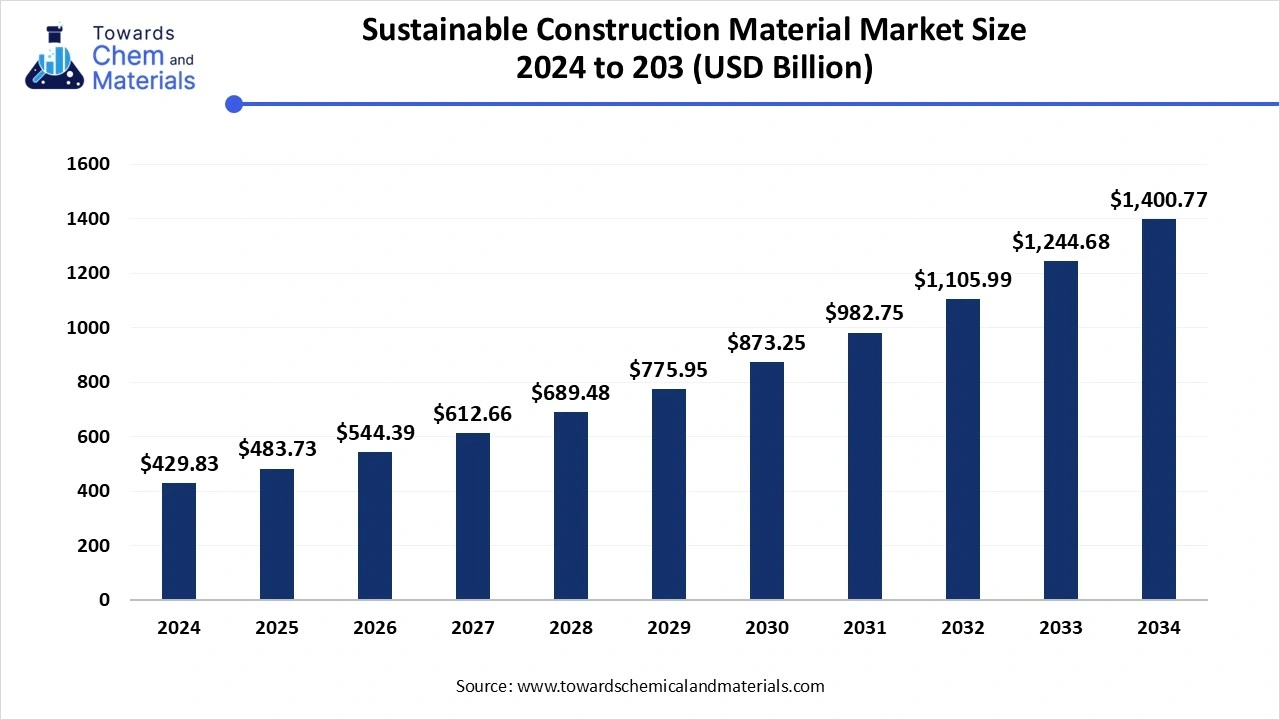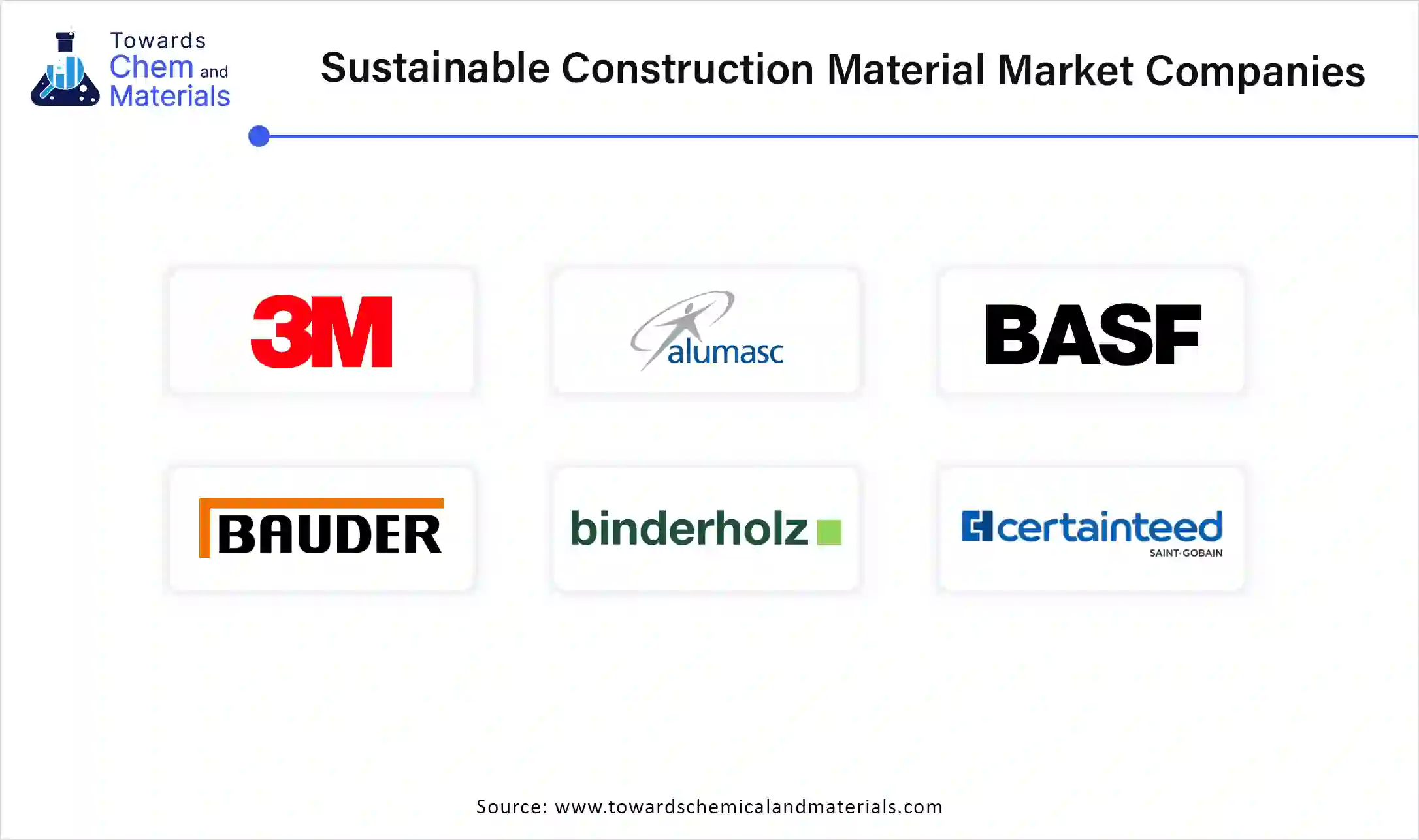November 2025
The global sustainable construction material market size was valued at USD 429.83 billion in 2024 and is expected to reach around USD 1,400.77 billion by 2034, growing at a CAGR of 12.54% from 2025 to 2034. The research and development activities and innovative material combinations are likely to generate substantial growth in the market.

The sustainable construction material market has witnessed stable growth in recent years. A trend toward an eco-friendly environment is a major factor leading the market in the current period. Construction materials such as advanced bio-based materials, recycled plastic-based cement, and hempcrete are gaining popularity in the current scenario.
The major investment in research and development programs by manufacturers is expected to drive industry growth in the coming years. The exploration of new material combinations integrated with advanced technology can contribute substantially to market progress for future period. Moreover, engineered timber products are likely to become popular during the forecast period by having properties such as carbon sequestering and higher strength.
| Report Coverage | Details |
| Market Size in 2025 | USD 483.73 Billion |
| Expected Market Size in 2034 | USD 1,400.77 Billion |
| Projected CAGR 2025 to 2034 | 12.54% |
| Dominant Region | North America |
| Base Year | 2024 |
| Segments covered | Type, End-user, and Regions |
| Key companies profiled | 3M, Alumasc Group Plc, BASF SE, Bauder Limited, Binderholz GmbH, CertainTeed, DuPont, Forbo Group, Interface Inc., Kingspan Group, Lafarge, National Fiber, Owens Corning, PPG Industries, RedBuil, LLC, Redware Wall Systems, Structurlam Mass Timber Corporation, and Others. |
The expansion of the prefabricated modular construction sector can create attractive market opportunities in the coming years. The components from this construction system are structured in factories and then assembled on sites. By reducing construction time with reducing waste and quality improvement, this construction system can gain significant market attraction during the forecast period. Also, these materials can offer better insulation, durability, and energy efficiency at the same time and will attract a strong consumer base.
The performance limitations as compared to traditional materials are anticipated to create market challenges for future periods. Some traditional materials such as steel and concrete have been used for a long time and it also improved over the decades. In comparison, materials like bio-based or hempcrete are likely to face some challenges such as moisture retention and fire resistance sometimes which can hamper market growth during the projected period.
North America dominated the sustainable construction material market in 2024. The heavy investments in green building initiatives and increased awareness of the benefits of eco-friendly products are leading the market in the current period. Countries in the region like Canada and the United States are actively promoting green environment initiatives and sustainable urban development earlier.
United States is a major growth contributor to the development of the sustainable construction market in North America. Having strong policies such as the Inflation Reduction Act (IRA) and various federal sustainability initiatives are offering tax incentives for developers who use recyclable elements in their construction sites. Moreover, the housing sector is also transforming in the United States by adopting technologically advanced sustainability initiatives.
For instance, One Click LCA and the U.S Green Building Council formed a strategic partnership. This collaboration aims to supply and access advanced LCA software and increase the promotion of efforts toward decarbonization in the construction industry in the United States.
Asia Pacific expects the fastest growth in the market during forecast period. Having strong natural resources of raw materials for sustainable construction can lead the industry expansion in the coming period. Furthermore, developers are seen in using innovative products such as cross-laminated timber (CLT) and bio-based insulation in construction with the promotion of eco-friendly construction initiatives. The rapidly growing population boosts the demand for the construction industry, which also contributed in the growth of the market.
China is anticipated to dominate the sustainable construction material industry in the future. Technological advancements such as 3D printing construction are likely to lead to market growth during the projected period. The developers in China seen using recycled plastic cement and other bio-based materials can create further growth opportunities for sustainable construction methods. Moreover, the implementation of smart city projects can significantly help to reach the country's goal of suitable construction in the coming period.
By Type
The bamboo segment held a dominant position in the sustainable construction materials market in 2024. Having superior strength, ecofriendly nature, and wide application, the bamboo-segment gained popularity over the years. Moreover, the high strength-to-weight ratio made bamboo a perfect material for construction activities during past decades.
The reclaimed wood segment is expecting significant growth in the market during the forecast period. Having qualities such as durability and generally stronger than newly harvested wood can make reclaimed wood stand out as a key ingredient in all the above raw materials. Also, this wood is anticipated to gain popularity as a great choice for flooring, load bearing, and furniture.
By End Use
The industrial segment dominated the market in 2024. The demand for environment-friendly infrastructures and operational cost reductions accelerating the adoption of sustainable construction material in the industrial construction. Sustainable construction materials are increasingly reducing energy consumption, minimizing wastes, and maintenance costs by applying in large-scale warehouses, power plants, and factories.
The residential segment is expected to grow at a significant CAGR during the forecast period. Factors such as a rising cost of energy and others are expected to drive segment growth in the future as the installation of sustainable materials like insulated concrete panels can improve energy efficiency by maintaining home temperatures. Schemes such as tax benefits, grants, and subsidies by the government are likely to contribute to segment growth.

Market analysis indicates that, the global chitosan market size was estimated at USD 16.19 billion in 2024 and is predicted to increase from USD 19.48...
November 2025
November 2025
November 2025
November 2025